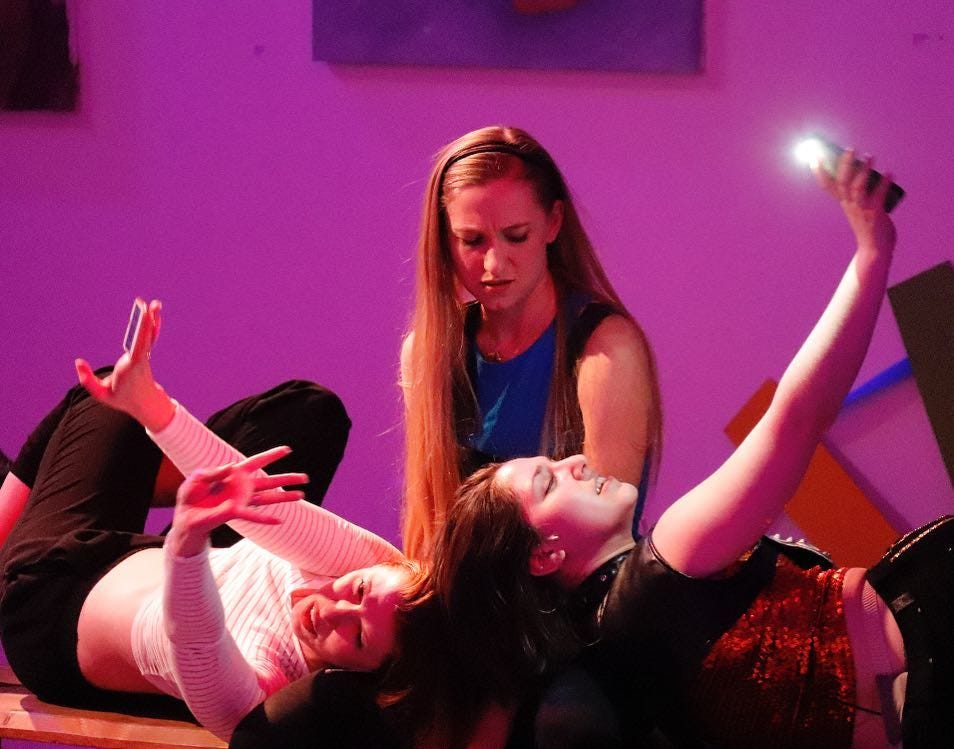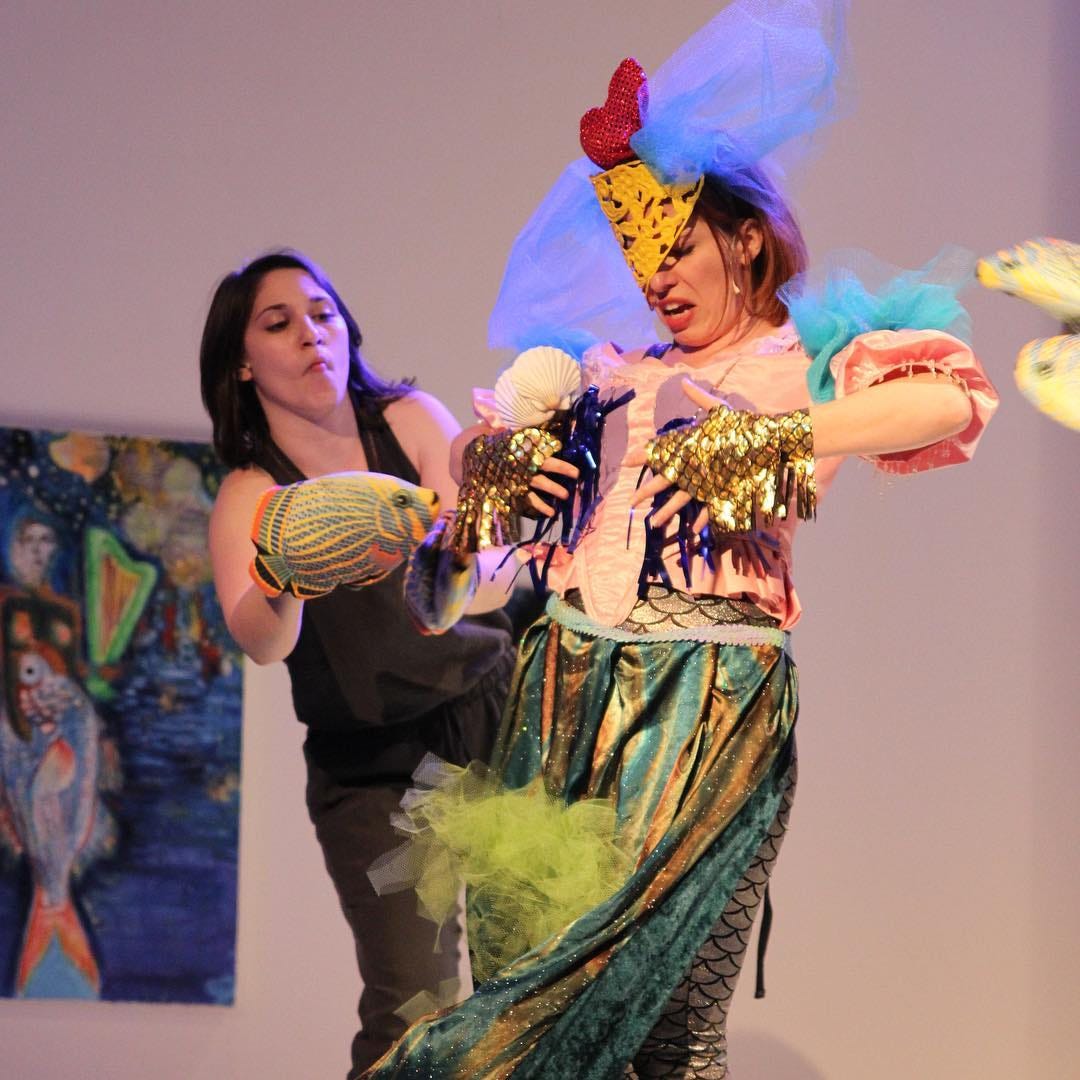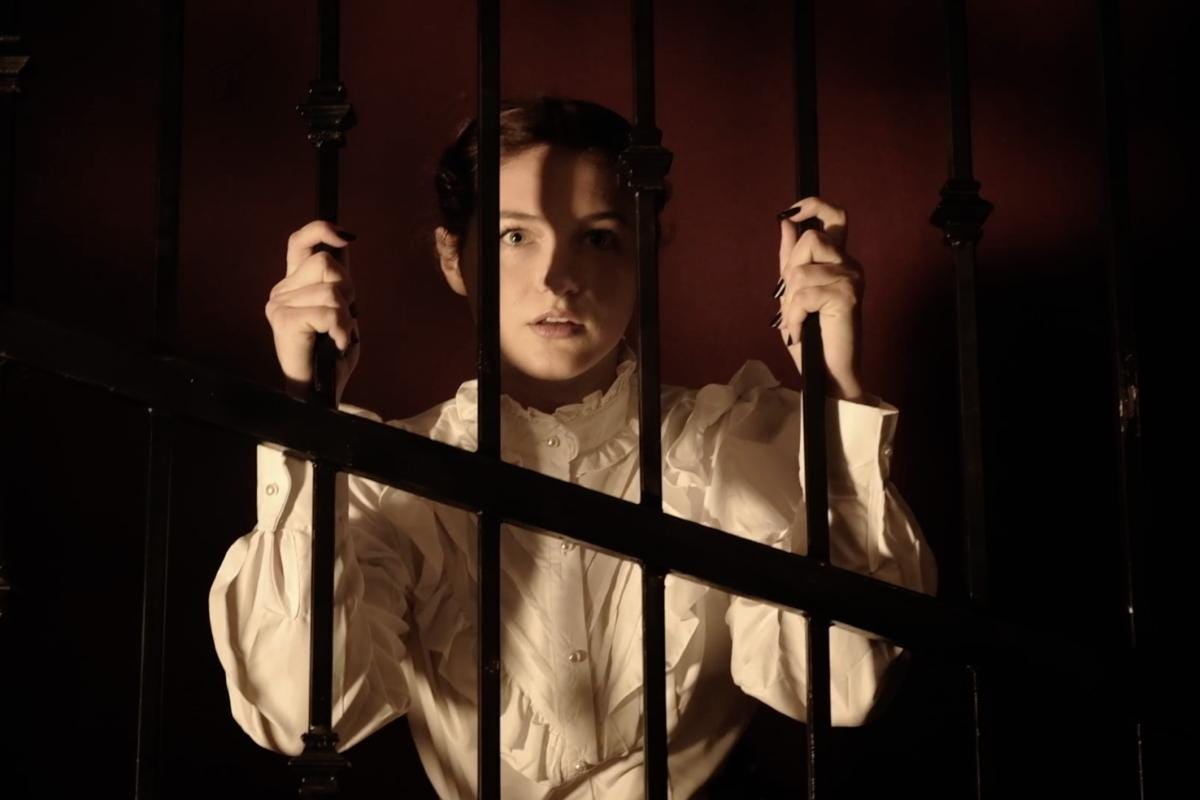
This grown-up musical retelling of the classic lacks color and clarity
Walking into the venue for the opening night of Painted Alice feels a bit like falling through the rabbit hole myself. I have arrived much too early and find myself locked out of “Wonderland,” trapped behind a door that will not open until the show begins. Luckily for me, the only potion I have to drink to get inside is a glass of wine while I wait. Finally, when the clock strikes 7:30 pm, I follow the fairy lights and some whimsical, hand-painted arrows to the Plaxall Gallery.
The gallery’s current exhibition, Drink Me, Taste Me, is a collection of Wonderland-inspired paintings, statues, and found objects. The crew bustles around me, making last-minute prop adjustments and setting up chairs. In the center of the gallery is a Mad Hatter-inspired table set for an unbirthday party. With the crew members distracted and a tempting platter of chocolates on display, I help myself to a juniper-flavored square. Small glass domes covering colorful cloths are interspersed among the place settings, each bearing a label with a different emotion.
I tentatively lift the lid to “joy” and sniff the cloth, the smell of cinnamon and something more peculiar filling my nose. A nervous-looking woman approaches me and says I’m supposed to wait until other guests are seated. I guiltily swallow the rest of the chocolate in my mouth and have a seat. Soon, I’m joined by the musical’s author and his family, one of the artists featured in the gallery, and a few other theater-goers. We drink cocoa-infused vodka and take turns smelling the “emotions.” And much too soon, the pre-show experience is over. We are directed to our seats and I pass wistfully by a dark, candlelit nook with an enormous hookah and floor cushions, regretful that I didn’t get a chance to try it before the show.

The play opens with our heroine, Alice (Tana Sirois), seated before her easel. In this version of the story, Alice is a professional artist struggling with a long stretch of painter’s block as she works on a commission from Parker, her high-profile, demanding client (played by Molly Kelleher). The typical Alice attire (a blue and white pinafore dress) has been swapped for black overalls and a white, paint-splattered apron. Dinah (Meghan Ginley) is no longer a kitten, but Alice’s girlfriend, who tries to coax her away from the painting to get some much-needed sleep. Alice is frustrated and lashes out, remaining in her studio while she listens to self-help tapes and waits for inspiration to come. “Come on Alice,” she sings, “just push through it,” but she can’t seem to get paint on the canvas. A call from her patroness interrupts her song. Alice is informed that she must come along as her patroness’ guest to a gallery opening the next evening.
With the commission still not started, Alice is in no position to decline the request. The event is a who’s-who of the art world and Alice shrinks under the spotlight. Her patroness flippantly informs her that one of Alice’s artist friends, Carol (Jamie Shapiro), has just died by suicide. While Alice stands in shock, Parker asks for help obtaining one of Carol’s last pieces — which is sure to be worth a fortune, now that she’s dead. Dinah then appears at the gallery on the arm of one of Alice’s rivals, starting a fight that leads to a break-up.
Alice returns home that evening on the verge of despair. She is grieving the loss of her friend, the end of her relationship, her struggle with creative expression, and a creeping feeling that she is a sell-out. As she sinks deeper into her depression, a chorus of singing voices and a vision of Dinah leads Alice towards her glowing, empty canvas, which she steps through, and emerges into Wonderland.

The audience is asked to rearrange our chairs in a circle, creating a new space that will be Alice’s Wonderland. We all scramble to line our chairs up with stickers on the ground; the mechanics are clunky but we eventually figure it out and settle into the new scene.
Alice’s first encounter in Wonderland is with a misshapen mermaid (Molly Kelleher) from one of her childhood drawings, who sings a delightful tale of woe about her strange appearance before retreating. Alice then finds herself at a group therapy session of failed artists as they lament the unfairness of their situations. The performance by Neal Davidson is a stand-out, as he plays an easily-angered artist whose only subject matter is a festering lesion on his thigh.
Get Cheyenne Ligon’s stories in your inbox
Join Medium for free to get updates from this writer.
SubscribeSubscribe
The group of artists moves on to a strange night-club environment. The audience is asked to reach under our chairs for a glow stick. We crack and wave them around while Alice and the artists take acid-laced brownies and sing a song about narcissism and social-climbing in the modern art scene. Through the artists’ gossip, Alice discovers that she must meet Wonderland’s richest and most temperamental patroness — Painted Alice’s version of the Queen of Hearts — to find her way back to her real life.
During her journey she has several more encounters with other artists who have also ended up in Wonderland. There is an artist who finds his career derailed by a new baby and a rural move; a Tweedle Dee and Tweedle Dum-inspired pair of artists in matching nightgowns; a Renaissance-era ancestor; and her recently-deceased friend Carol from the real world. Each encounter poses a different question.
Does domestic happiness stifle creative expression?
What has more value, commercial success or critical success?
Should you choose love or art?
What drives someone to end their own life?

Each of these questions deserves complicated, weighty answers and could be the subject of its own play. But Painted Alice merely asks questions and doesn’t answer any of them. Alice spins on, bouncing from one interaction to the next until she finds herself in a situation nearly identical to her real-life situation: she is commissioned to paint a portrait of Wonderland’s patroness and decides to reject it. A trial ensues, and Alice struggles to defend herself against the kangaroo court of her artist peers. She eventually escapes and returns to her life in the real world, bringing along with her a newfound sense of confidence and self-expression supposedly learned in Wonderland.
Painted Alice was entertaining and benefited from good acting and singing and intermittently-funny lyrics and dialog. But its lack of commitment to exploring any themes in depth left it feeling shallow. And aside from some reproductions of pieces from the Drink Me, Taste Me exhibit, Painted Alice did not engage with its surroundings. The cast never interacted with the guests; aside from moving our chairs and intoning an Alcoholics Anonymous-style “Hiiiiii Alice” at the artists’ group therapy session, we were passive observers rather than active participants. The skeleton of an interactive and immersive experience was evident but clunky mechanics and the absence of any opportunity for variability, exploration, and chance encounters left me disappointed and wishing for more.
The heart of Alice’s journey through Wonderland is exploration and subsequent self-discovery. If Painted Alice really wants to take its audience to Wonderland alongside its heroine, we must be able to do more than passively watch.
Painted Alice by Long Island City Artists has concluded.
NoPro is a labor of love made possible by our generous Patreon backers. Join them today!
In addition to the No Proscenium web site, our podcast, and our newsletters, you can find NoPro on Twitter, Facebook, YouTube, Instagram, in the Facebook community Everything Immersive, and on our Slack forum.
Office facilities provided by Thymele Arts, in Los Angeles, CA.















Discussion